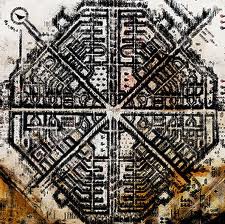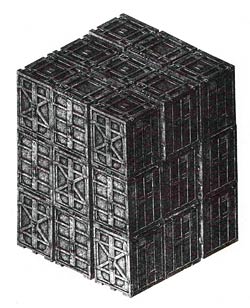Pavlo Makov has a unique style. No other artist in Ukraine and very few painters in the world work in this manner. His works are more than etchings. They are reflections of time that are so accurate, that they first exude half-forgotten ornaments, routes, plans and schemes, and when you look closer – also individual details and symbols. Eventually, Mr. Makov’s etchings become illustrations in books, parts of design and his own exclusive games, one of which is a glossary of symbols and meanings, compiled in cooperation with The Ukrainian Week.
Graphics. This is a rarely used and somewhat outdated term. It still exists in Germany and former Soviet republics. The whole world uses another word for what I do today. They call it art on paper, which includes prints, water-colours and oil paintings. Paper is the key component of this style of creativity. When I say I’m a graphic artist in the West, everyone will think I work with a computer – this is what web-designers are called there.

Donroza from the Gardens cycle, 2008-2010
Scandals. I’m not interested in causing scandals. The reality of our life is much more scandalous than art. Scandals generally fill voids in art, where there is nothing else to show. But remember, scandals are an important element of modern art.
Classics. In my view, there is no such thing. Leonardo da Vinci is an example of exaggerated classics in fine art. But every time I am lucky enough to view his paintings intimately, with not too many people around, I think of him as my contemporary. It does not seem as if there are five centuries between us. I recently had the great fortune to see Giotto di Bondone’s frescoes in the Scrovegni Chapel in Padua. Are they classics or modern art? I would put it differently: it is that, which to this day, still has a huge influence on everyone. Hans Ulrich Gumbrecht, the German-born American literary theorist, has a similar impact on me. I know him personally and am a great fan of his ideas. Before him, nobody managed to explain such important things to me in words. Is he a classic or a modern? And who can be more modern than Gogol in Ukraine? So you see, “classic” is an obscure term. Art can be interesting or uninteresting, but certainly not classic or modern. Remember, it is time that always determines what is current and what is not.
Government. My attitude to it is very simple. I realize that art has never changed a government, even if it has an obvious political undertone. Thus, my whole life is built in such a way, that I depend on it as little as possible. I refuse to hold administrative positions, titles or decorations granted by the government. I’m not an honored artist because I’ve never served anyone.
Culture. This is the ability to co-exist. Literature, music, painting and theater are only small instruments that help us understand how to continue living and find our course together.
The original. As far as my creativity is concerned, the existence of the original and absence of copies is related to the specific features of the production process. Over the past few centuries, as long as etching has existed, artists produced a plate and printed a number of copies from it. I work with plates, photographs and painting. It is impossible to copy any of my works. Even I can’t do it. I know that Ilya Repin had made several copies of his “Zaparozhye Cossacks Writing a Mocking Letter to the Turkish Sultan” in the 19th century because it was hugely popular. But for me, this is a bitter page in the history of art: instead of creating something new, Repin was forced to earn a living. I would go crazy if I had to copy my own works.
Utopia. Ever since I first mentioned this word in my art to describe a non-existent country, it has continued to be relevant. A long time ago I thought former Soviet states were undefined utopias. Now I see that this is also the case for Europe and the US. Gumbrecht described this in his book entitled “In 1926: Living on the Edge of Time”. It’s about a past that does not teach us anything.

The Tower
The Kharkiv Art School. For me, Kharkiv art is Borys Kosarev, Vasyl Yermilov and Vitaliy Kulykov. I consider the latter to be my teacher, but not in the sense of the existence of a specific local school. Kosarev was simply not given an opportunity to establish it during the soviet era. Yermilov lived in Kharkiv but couldn’t influence art life in the city at that time, because it was the time when Kharkiv was a stronghold of socialism. It is not difficult to notice that the above-mentioned artists are completely different and the artwork of one didn’t inspire that of another. If there is a Kharkiv school somewhere, I’d say that it’s in the area of photography. There is the Borys Mykhailov generation, another is that of Serhiy Bratkov and there are many other incredibly talented photo artists out there.
An artist, is someone who paints professionally. That’s it. Nothing extraordinary. It’s a simple, routine profession – one of the oldest. People were painting and drawing before they ever learned to talk. Just do your work well and history will take care of the rest.
BIO
Pavlo Makov was born in Leningrad in 1958. He lives and works in Kharkiv. Mr. Makov is a member of Royal Society of Painter-Printmakers UK and a correspondence member of the Art Academy of Ukraine. His works are exhibited at the Victoria and Albert Museum in London, the Metropolitan Museum in New York, the National Art Gallery in Kyiv, the Osaka Contemporary Art Center, the Tretiakov Gallery in Moscow, the Contemporary Art Museum in Ibiza, and in other collections. In 2009, Mr. Makov’s works were put up for auction at Sotheby’s.
Books
Donroza, 2011
Private Books and Diaries, 2007
Utopia. Chronicles 1992-1995, 2006
The Book of Days, 2000
The Anatomy of a Target and All Others…, 1999
Our Landscape, 1998
The Best of Printmaking, 1997

